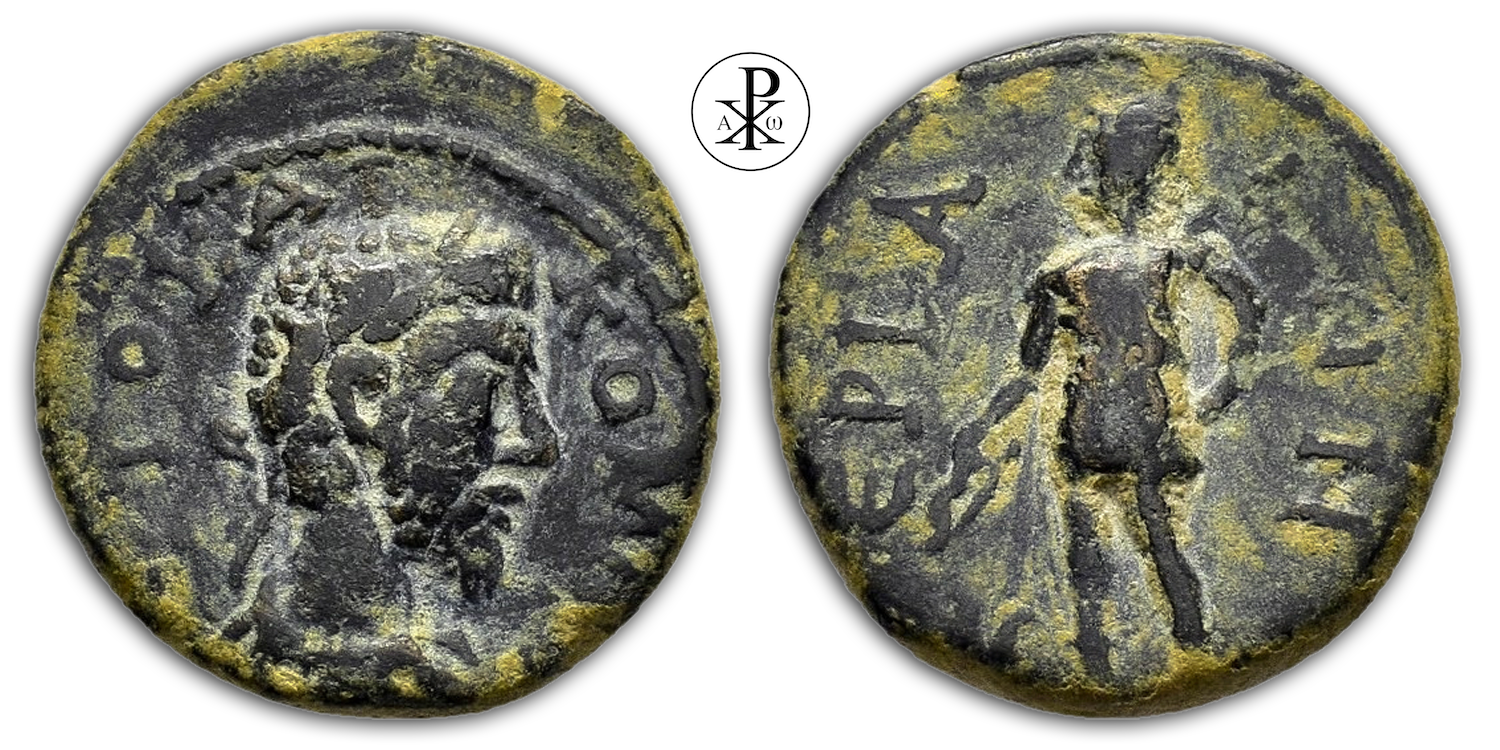Imperator Caesar Marcus Aurelius Commodus Antoninus Augustus
Reign: Commodus
Mint: Perge, Pamphylia
Date: 180/192 AD
Nominal: Bronze
Material: AE
Diameter: 17mm
Weight: 4.80g
Reference: RPC IV.3 17562 (this coin)
Reference: SNG France 3 419
RPC Online: https://rpc.ashmus.ox.ac.uk/coins/4/17562
SNG Online: https://catalogue.bnf.fr/ark:/12148/cb41781168m
BaWü Online: https://bawue.museum-digital.de/object/64046?navlang=de
Rare: Specimens 3 (1 in the core collections)
Provenance: Biga Numismatics Drunen, Netherlands (Auction 16, Lot 163)
Pedigree: –
Special: 3rd known example, RPC Online Plate coin
Obverse: Laureate-headed bust of Commodus wearing cuirass and paludamentum, right
Inscription: AVTO KAI KOMMO
Translation: Autokrator Kaisaros Kommodos
Translation: Imperator Caesar Commodus
Reverse: Artemis Pergaia standing left, quiver at shoulder, holding bow
Inscription: ПEPΓAIΩN
Translation: Pergaion
Translation: City of Perge
Comment: Perge is an ancient city 14 kilometres inland from the south coast of Turkey and 16 kilometres northeast of Antalya (ancient Attaleia) in Aksu. Along with Side, it was the most important city in Pamphylia. The ruins still standing today give a good impression of a city complex of the late Hellenistic-Roman period. Coming from the coast or from Antalya, the ancient theatre of Perge is located to the west (left). It had a capacity of 14,000 spectators, making it one of the largest of its kind. Between the theatre and the city is a large, well-preserved stadium with 15,000 seats and 50 vaults supporting the still well-preserved rows of seats. Some of them served as shops, every third one as an entrance. Towards the city, there are palace ruins from the imperial period and the large Palaestra, which is part of a large gymnasium. At the west gate are the thermal baths – an aqueduct can also be seen – and behind them the necropolis. The strategically located table mountain in the north has been called the Acropolis since the work of Karl Graf Lanckoronski (1890), because the main street of the city runs right up to it. On the south-eastern edge of the Acropolis was the extensive sanctuary of Artemis (known as Artemis Pergaia), whose cult – as in Ephesus – shaped the arts and the economy. Not least, this is evident on many an ancient coin (such as the one presented here). In Greek mythology, Artemis is the goddess of hunting, virginity, the forest, birth and the moon, as well as the guardian of women and children. She is one of the twelve great Olympian gods. She is the daughter of Zeus and Leto and the twin sister of Apollo. She corresponds to Diana in Roman mythology.
Perge, the hometown of Artemis Pergaia and her cult, stamped the image of the goddess on coins almost continuously, beginning in Hellenistic times (2nd century BC). At the same time, Artemis Pergaia was also the patron goddess of the entire regional centre of Perge – and was often closely related to the other Pamphylian and Pisidian communities through personal and commercial ties. Thus, the cult later spread far beyond the regional borders. From Hellenistic times, various sources contain references to temples, priests and institutionalised or private cult of the goddess from Perge. In ancient times, Artemis Pergaia was conceived and understood in two different image forms: Once as the huntress Artemis in long or short garb in a purely Greek iconography with bow or torch, the other time in an „ancient“ appearance as aniconic cult icon, idol or baitylos with human head. The most important and most detailed study on the image of Artemis on the city coins of Perge was presented by Th. S. MacKay in 1990. It is the first to discuss in detail the divergent representations and to attempt to interpret them.
The type presented here seems to be extremely rare. I know of one specimen in the Freiburg Museum Baden Württemberg (Germany) and one specimen at SNG, plus this specimen. I have not found any other pieces during my internet research, nor any pieces at auctions in the last 20 years. Addendum: the coin type has now been added to RPC Online (SNG type, Freiburg Museum Baden Württemberg type and this coin).
